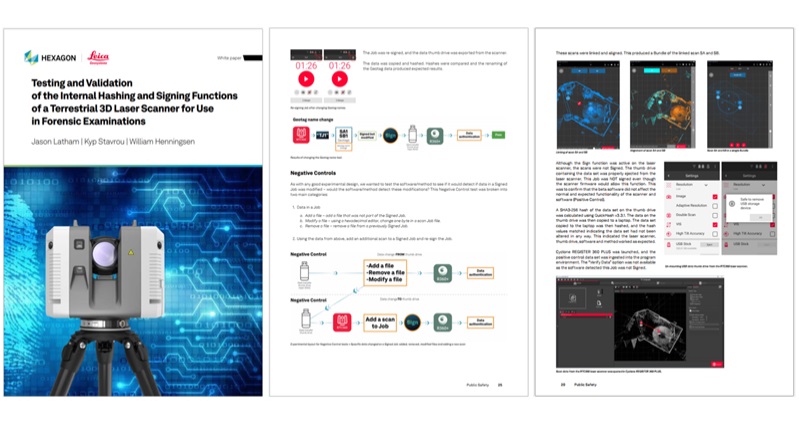One of the many challenges crime, crash and fire investigators and forensic examiners face is the need to accurately and reliably capture vital information about the incident scene, including all evidence. With the rise of 3D laser scanning in public safety applications, the integrity and security of the captured data have become paramount. What if there exists a technology that can make such data not just credible but also tamper-proof?
Herein lies the importance of digital signature/hashing – a cryptographic technique ensuring digital information’s authenticity and integrity. This technique serves as a safeguard against data manipulation and unauthorised access, which could lead to serious consequences such as compromised investigations or false conclusions. Preserving the integrity of any evidence collected for forensic use is paramount in any investigation.
This blog explains the importance of data integrity and authenticity using laser scanning in forensic examination. Read on to discover how to ensure the originality of the data you collect from crime, collision, or fire scenes has not been altered and why our technology adheres to the highest data security standards.
Understanding Digital Signature and Hashing
Understanding the function of a digital signature and the hashing process, it is essential to appreciate their role in enhancing data integrity. A digital signature is a cryptographic tool that allows recipients of digital data to verify its authenticity and integrity using hashing. Hashing generates a unique character/number string called “hash value”, “digital signature”, or “digital fingerprint”.

Job signature – the hash value created in the job folder when the job is signed
Important to understand is, that hashing does not equal encryption. Hashed data is digitally signed with a unique, unreversible code. Encryption is the process of scrambling plaintext into unreadable ciphertext, which can be decrypted with a relevant key.
Hashing ensures data integrity and authenticity. Hashing plays a significant role in generating a unique identifier, just like a fingerprint, for every piece of data (a single scan or the whole scanning job), enabling the detection of any changes in the original scan data from the incident scene. Furthermore, a digital certificate is a type of digital identification that validates the ownership of a digital signature. These components combined provide a robust security measure, emphasizing the importance of digital signature and hashing for laser scanning in forensic examination and reassuring the reliability of the data.
Unlock the world of algorithms, hash values, and digital fingerprints as we delve into how Leica Geosystems, part of Hexagon, enables the forensic validity of your laser scanning data through onboard signing processes. Download our exclusive white paper now and step into the future of secured laser scanning in forensics.
Importance of Data Security in Forensic Examination
Evidence is a crucial element in trials and court proceedings. However, the authenticity of evidence or any data presented can be challenged. Whether unintentional or deliberate, data manipulations can change narratives and lead to unjust outcomes.
Hence, the significance of data security cannot be understated in the sphere of public safety. Laser scanning data can contain sensitive information about a crime, homicide, collision, or arson scene and needs to be safeguarded from unauthorised access and tampering. Without robust security measures like digital signatures, the confidentiality and integrity of this data can easily become compromised. Furthermore, legal and regulatory standards like the National Institute of Standards and Technology (NIST), National Institute of Justice (NIJ), the Federal Information Processing Standard (FIPS), the US Federal Rule of Evidence 902, ISO 17020 and many others emphasise the importance of digitally signing for laser scanning in public safety and forensics.
Delve deep into how this feature authenticates RTC360 scan data within Leica’s Cyclone software and much more. Explore this expert insight article now for the full perspective.
Forensically-Sound Data Security-Workflow in Laser Scanning
Upon initial use, the Data Security feature on the RTC360 laser scanner needs to be activated. This ensures the addition of a cryptographic digital signature to scans immediately post-capture.
Digital signatures are accessible for verification within Cyclone REGISTER 360 PLUS office software. Once activated, the digital signature seamlessly transitions to the default setting for all subsequent tasks/scans. The feature enables users to engage in on-device hashing of data, facilitating authentication specific to the device. REGISTER 360 PLUS software has built-in verification and reporting functions, allowing independent verification of each scan signature through the SHA3-256 hash generator.
The Data Security feature comprises two key elements: the initiation of an independent hash for every scan or data component and the option for users to sign/hash the whole scanning job with an authentic device signature upon completion. Additional evidence, such as scan setups, can be incorporated into the job. However, it would require the user to re-sign the files. Simplifying the workflow, built-in verification is seamlessly achievable through Leica Cyclone REGISTER 360 PLUS.
Visit our website to explore the step-by-step tutorial on enabling the data security workflow on your Leica RTC360
Best Practices for Implementing Digital Signature, Digital Certificates and Hashing
Adopting best practices and providing adequate training to effectively utilise digital signatures in laser scanning is crucial. This includes using industry-standard algorithms, regular updates, and software and hardware maintenance. Compatibility and interoperability are key considerations for integrating these technologies into existing systems. Training programs covering the basics and advanced topics related to digital signatures, digital certificates and hashing equip public safety professionals with the necessary skills and knowledge.
At Hexagon, we understand the world of complex technology and the necessity for user-friendly integration. To navigate this, we have seamlessly incorporated digital signature and hashing through the Data Security feature in Leica REGISTER 360 PLUS, ensuring data authenticity from the field to the courtroom every step of the way.

Trust but verify. Kyp Stavrou (CEO and owner of Complete Digital Forensic Solutions, Inc.) and Ryan Rezelle (Public Safety Segment Manager US/CAN) discuss the validation process.
Learn directly from the expertise and insights of Kyp Stavrou, CEO and Owner of Complete Digital Forensic Solutions, and see how these intricate practices come to life in this enlightening customer testimonial video.
Future of Digital Signature and Hashing in Public Safety and Forensics
The future of digital signatures, digital certificates, and hashing in public safety and forensic examination looks promising, with constant technological advancements enhancing their security and efficiency. Emerging trends, such as the integration of AI and blockchain, are opening up new possibilities for real-time data analysis, automated decision-making, and secure data storage. With blockchain’s structurally immutable nature, we can anticipate similar mechanisms to elevate the roles of digital signing and hashing in public safety. Beyond laser scanning, these technologies find applications in various aspects of public safety, such as incident response and forensic analysis. As digital signature and hashing continue to evolve, public safety professionals need to gear up for a more sophisticated and high-tech future. The challenge is inevitably to keep pace with technology. Hexagon’s commitment to providing opportunities for training and education ensures that no public safety professional feels left behind in the race.
At Hexagon, we stand for shaping smart change and empowering a future that thrives on trust in data. It’s time to secure your data with the power of a tamper-proof digital shield – the Data Security feature in our Cyclone REGISTER 360 PLUS.















